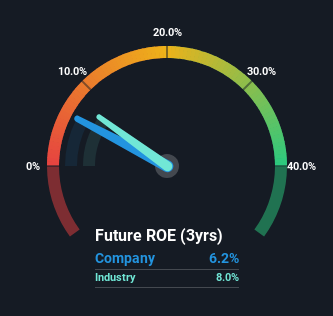With A 6.2% Return On Equity, Is UGI Corporation (NYSE:UGI) A Quality Stock?
With A 6.2% Return On Equity, Is UGI Corporation (NYSE:UGI) A Quality Stock?
Many investors are still learning about the various metrics that can be useful when analysing a stock. This article is for those who would like to learn about Return On Equity (ROE). We'll use ROE to examine UGI Corporation (NYSE:UGI), by way of a worked example.
許多投資者仍在學習分析股票時可能有用的各種指標。本文針對那些希望了解股東權益回報率(ROE)的人。我們將通過一個示例來使用ROE來分析UGI公司(紐交所:UGI)。
Return on equity or ROE is a key measure used to assess how efficiently a company's management is utilizing the company's capital. In simpler terms, it measures the profitability of a company in relation to shareholder's equity.
淨資產收益率(ROE)是評估公司管理層如何有效利用公司資本的關鍵指標。簡單來說,它衡量了公司相對於股東權益的盈利能力。
How To Calculate Return On Equity?
如何計算股東權益回報率?
Return on equity can be calculated by using the formula:
淨資產收益率可以通過以下公式計算:
Return on Equity = Net Profit (from continuing operations) ÷ Shareholders' Equity
股東權益回報率 = 凈利潤(來自持續運營)÷ 股東權益
So, based on the above formula, the ROE for UGI is:
因此,根據上述公式,UGI的ROE爲:
6.2% = US$269m ÷ US$4.4b (Based on the trailing twelve months to September 2024).
6.2% = 26900萬美金 ÷ 44億美金(基於截至2024年9月的過去十二個月)。
The 'return' refers to a company's earnings over the last year. One way to conceptualize this is that for each $1 of shareholders' capital it has, the company made $0.06 in profit.
「回報」是指公司過去一年的收益。一個概念化的方法是,對於每1美元的股東資本,公司盈利爲0.06美元。
Does UGI Have A Good ROE?
UGI的ROE好嗎?
Arguably the easiest way to assess company's ROE is to compare it with the average in its industry. Importantly, this is far from a perfect measure, because companies differ significantly within the same industry classification. As shown in the graphic below, UGI has a lower ROE than the average (8.0%) in the Gas Utilities industry classification.
評估一家公司的ROE最簡單的方法是將其與行業的平均水平進行比較。重要的是,這遠不是一個完美的衡量標準,因爲同一行業內的公司差異顯著。如下面的圖形所示,UGI的ROE低於公用股行業分類的平均水平(8.0%)。

Unfortunately, that's sub-optimal. That being said, a low ROE is not always a bad thing, especially if the company has low leverage as this still leaves room for improvement if the company were to take on more debt. A company with high debt levels and low ROE is a combination we like to avoid given the risk involved. To know the 3 risks we have identified for UGI visit our risks dashboard for free.
不幸的是,這並不理想。話雖如此,低ROE並不總是壞事,尤其是當公司槓桿率低時,這仍然留有改善的空間,如果公司要承擔更多債務的話。高負債水平和低ROE的公司是我們希望避免的組合,因爲涉及的風險較大。要了解我們爲UGI識別的三個風險,請免費訪問我們的風險儀表。
Why You Should Consider Debt When Looking At ROE
爲什麼在觀察ROE時你應該考慮債務問題?
Companies usually need to invest money to grow their profits. That cash can come from retained earnings, issuing new shares (equity), or debt. In the first two cases, the ROE will capture this use of capital to grow. In the latter case, the use of debt will improve the returns, but will not change the equity. In this manner the use of debt will boost ROE, even though the core economics of the business stay the same.
公司通常需要投資資金以增長利潤。這些資金可以來自留存收益、發行新股票(股本)或債務。在前兩種情況下,ROE將捕捉到這種用於增長的資本使用。而在後者的情況下,使用債務將提升回報,卻不會改變股本。通過這種方式,使用債務儘管核心經濟狀況不變,但會提升ROE。
UGI's Debt And Its 6.2% ROE
UGI的債務及其6.2%的ROE
It's worth noting the high use of debt by UGI, leading to its debt to equity ratio of 1.63. Its ROE is quite low, even with the use of significant debt; that's not a good result, in our opinion. Investors should think carefully about how a company might perform if it was unable to borrow so easily, because credit markets do change over time.
值得注意的是,UGI的高債務使用,使其債務與股本比率達到了1.63。儘管使用了大量的債務,其ROE仍然相當低;在我們看來,這並不是一個好的結果。投資者應謹慎思考,如果一家公司無法如此輕鬆借貸,其表現可能會如何,因爲信用市場是會隨着時間變化的。
Conclusion
結論
Return on equity is useful for comparing the quality of different businesses. Companies that can achieve high returns on equity without too much debt are generally of good quality. If two companies have the same ROE, then I would generally prefer the one with less debt.
股本回報率(ROE)對於比較不同企業的質量非常有用。能夠在沒有過多債務的情況下實現高ROE的公司通常質量較好。如果兩家公司的ROE相同,我通常會選擇負債較少的那一家。
Having said that, while ROE is a useful indicator of business quality, you'll have to look at a whole range of factors to determine the right price to buy a stock. It is important to consider other factors, such as future profit growth -- and how much investment is required going forward. So I think it may be worth checking this free report on analyst forecasts for the company.
儘管如此,雖然ROE是評估業務質量的有用指標,但您需要考慮一系列因素來判斷買入一隻股票的合適價格。考慮其他因素是很重要的,例如未來利潤增長——以及未來所需的投資金額。因此,我認爲查看關於該公司的分析師預測的免費報告可能會很有價值。
But note: UGI may not be the best stock to buy. So take a peek at this free list of interesting companies with high ROE and low debt.
但是請注意:UGI 可能不是最佳的買入股票。因此,看看這個免費的有趣公司列表,這些公司具備高ROE和低債務。
Have feedback on this article? Concerned about the content? Get in touch with us directly. Alternatively, email editorial-team (at) simplywallst.com.
This article by Simply Wall St is general in nature. We provide commentary based on historical data and analyst forecasts only using an unbiased methodology and our articles are not intended to be financial advice. It does not constitute a recommendation to buy or sell any stock, and does not take account of your objectives, or your financial situation. We aim to bring you long-term focused analysis driven by fundamental data. Note that our analysis may not factor in the latest price-sensitive company announcements or qualitative material. Simply Wall St has no position in any stocks mentioned.
對本文有反饋?對內容有疑慮?請直接與我們聯繫。或者,發送電子郵件至 editorial-team (at) simplywallst.com。
這篇來自Simply Wall ST的文章是一般性的。我們根據歷史數據和分析師預測提供評論,採用無偏見的方法,我們的文章並不旨在提供財務建議。它不構成對任何股票的買入或賣出建議,也未考慮到您的目標或財務狀況。我們旨在爲您提供以基本數據驅動的長期分析。請注意,我們的分析可能未考慮最新的價格敏感公司公告或定性材料。Simply Wall ST在提到的任何股票中均沒有持倉。

 Return on Equity = Net Profit (from continuing operations) ÷ Shareholders' Equity
Return on Equity = Net Profit (from continuing operations) ÷ Shareholders' Equity